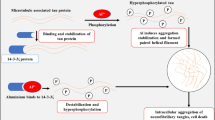Abstract
Evidence regarding the role of mercury and aluminum in the pathogenesis of Alzheimer’s disease (AD) remains controversial. The aims of our project were to investigate the content of the selected metals in brain tissue samples and the use of a specific mathematical transform to eliminate the disadvantage of a strong positive skew in the original data distribution. In this study, we used atomic absorption spectrophotometry to determine mercury and aluminum concentrations in the hippocampus and associative visual cortex of 29 neuropathologically confirmed AD and 27 age-matched controls. The Box–Cox data transformation was used for statistical evaluation. AD brains had higher mean aluminum concentrations in the hippocampus than controls (0.357 vs. 0.090 μg/g; P = 0.039) after data transformation. Results for mercury were not significant. Original data regarding microelement concentrations are heavily skewed and do not pass the normality test in general. A Box–Cox transformation can eliminate this disadvantage and allow parametric testing.

Similar content being viewed by others
References
Andrási E, Páli N, Molnár Z, Kösel S, Andrasi E, Pali N, Molnár Z, Kostel S (2005) Brain aluminum, magnesium and phosphorus contents of control and Alzheimer-diseased patients. J Alzheimers Dis 7:273–284
Barnham KJ, Bush AI, Metals in Alzheimer's and Parkinson’s diseases (2008) Curr Opin Chem Biol 12:222–228
Box GEP, Cox DR (1964) An analysis of transformations. J R Stat Soc 26:211–252
Bush AI (2003) The metallobiology of Alzheimer’s disease. Trends Neurosci 26:207–214
Bush AI (2008) Drug development based on the metals hypothesis of Alzheimer’s disease. J Alzheimers Dis 15:223–240
Bush AI, Tanzi RE (2008) Therapeutics for Alzheimer’s disease based on the metal hypothesis. Neurotherapeutics 5:421–432
Caragounis A, Du T, Filiz G, Laughton KM, Volitakis I, Sharples RA, Cherny RA, Masters CL, Drew SC, Hill AF, Li QX, Crouch PJ, Barnham KJ, White AR (2007) Differential modulation of Alzheimer’s disease amyloid beta-peptide accumulation by diverse classes of metal ligands. Biochem J 407:435–450
Ehmann WD, Markesbery WR, Alauddin M, Hossain TI, Brubaker EH (1986) Brain trace elements in Alzheimer’s disease. Neurotoxicology 7:195–206
Finefrock AE, Bush AI, Doraiswamy PM (2003) Current status of metals as therapeutic targets in Alzheimer’s disease. J Am Geriatr Soc 51:1143–1148
Fujimura M, Usuki F, Sawada M, Takashima A (2009) Methylmercury induces neuropathological changes with tau hyperphosphorylation mainly through the activation of the c-jun-N-terminal kinase pathway in the cerebral cortex, but not in the hippocampus of the mouse brain. Neurotoxicology 30:1000–1007
Fung YK, Meade AG, Rack EP, Blotcky AJ (1997) Brain mercury in neurodegenerative disorders. J Toxicol Clin Toxicol 35:49–54
Godfrey ME, Wojcik DP, Krone CA (2003) Apolipoprotein E genotyping as a potential biomarker for mercury neurotoxicity. J Alzheimer Dis 5:189–195
Grant WB, Campbell A, Itzhaki RF, Savory J (2002) The significance of environmental factors in the etiology of Alzheimer’s disease. J Alzheimers Dis 4:179–189
Jellinger KA (2003) General aspects of neurodegeneration. J Neural Transm Suppl 65:101–144
McDermott JR, Smith AI, Iqbal K, Wisniewski HM, McDermott JR, Smith AI, Iqbal K, Wisniewski HM (1985) Brain aluminum in aging and Alzheimer disease. Neurology 29:809–914
Miu AC, Benga O (2006) Aluminum and Alzheimer’s disease: a new look. J Alzheimers Dis 10:179–201
Nylander M, Friberg L, Eggleston D, Björkman L, Nylander M, Friberg L, Eggleston D, Bjorkman L (1989) Mercury accumulation in tissues from dental staff and controls in relation to exposure. Swed Dent J 13:235–243
Olivieri G, Brack C, Müller-Spahn F, Stähelin HB, Herrmann M, Renard P, Brockhaus M, Hock C (2000) Mercury induces cell cytotoxicity and oxidative stress and increases beta-amyloid secretion and tau phosphorylation in SHSY5Y neuroblastoma cells. J Neurochem 74:231–236
Rusina R, Matej R, Urban P, Cabelkova Z, Nerudova J, Cikrt M (2006) Regional mercury concentration in Alzheimer's disease brains. Eur J Neurol 13(Suppl 2):195
Seber GAF, Wild CJ (1989) Nonlinear regression. Wiley, New York
Shcherbatykh I, Carpenter DO (2007) The role of metals in the etiology of Alzheimer’s disease. J Alzheimers Dis 11:191–205
Stewart WF, Schwartz BS, Simon D, Kelsey K, Todd AC (2002) APOE genotype, past adult lead exposure, and neurobehavioral function. Environ Health Perspect 110:501–505
Acknowledgments
The authors wish to thank Thomas Secrest for revisions on the English version of this article. This study was partly supported by Grant SGS10/092/OHK4/1T/14 and Grant No 309/09/P204 of the Grant Agency of Czech Republic and research program MŠM 0021620849 of the Czech Ministry of Education.
Author information
Authors and Affiliations
Corresponding author
Rights and permissions
About this article
Cite this article
Rusina, R., Matěj, R., Kašparová, L. et al. Higher Aluminum Concentration in Alzheimer’s Disease After Box–Cox Data Transformation. Neurotox Res 20, 329–333 (2011). https://doi.org/10.1007/s12640-011-9246-y
Received:
Accepted:
Published:
Issue Date:
DOI: https://doi.org/10.1007/s12640-011-9246-y




